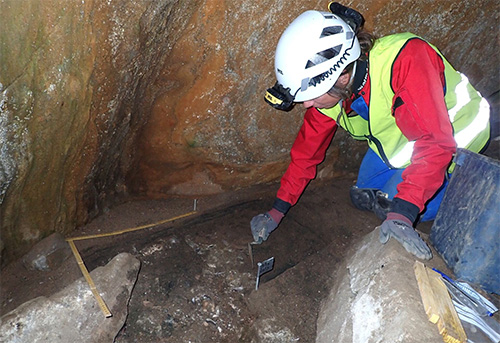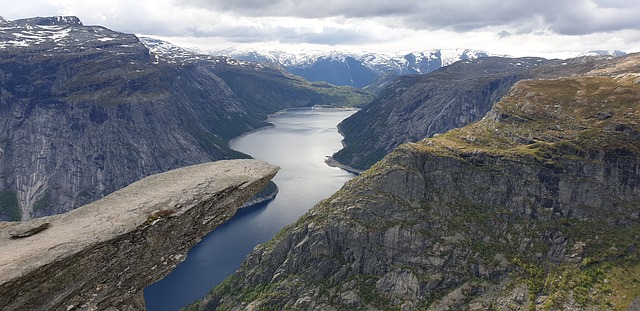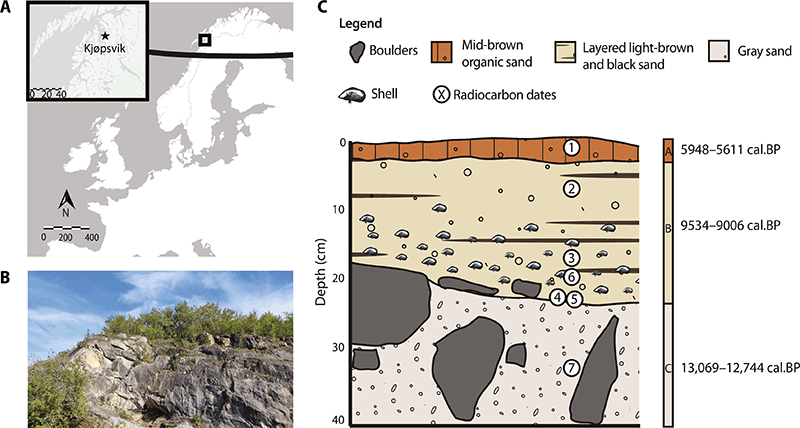This new study pokes holes in the dogma five different ways
Credit to Kenneth Richards who found the study and discussed it at NoTricksZone
Bones in a cave inside the Arctic circle show that the world was hotter, the climate is always changing, and life adapts very well.
A special cave in far northern Norway has a a trove of thousands of old bones. They are deposited in layers that stretch back from 5,800 years ago to 13,000 years ago. And it’s been a radical change: at the start, the cave was submerged under the ocean, so the bones are mostly marine species. But a few thousand years later the weather was warm, and birds and mammals had moved in. By 6,000 years ago the researchers estimate it was the hottest part of the Holocene and 1.5°–2.4°C warmer than the modern era of 1961–1990.
After that, the cave was blocked by scree, and the bone fragments sat there seemingly undisturbed for nearly 6,000 years while the ice sheets moved and the Vikings came and went and the world cooled. Then in 1993 someone happened to build a road nearby and found the cave. Now a team have analyzed the DNA in the layers and discovered that far from being an ecological disaster, when the Earth was hotter the Arctic must have been full of life. They found lemmings, shrews, voles, hares, geese, frogs, seals, and pheasants. They were also surprised to find dogs and cats there, even though there were no humans at the time (that we know of). The DNA test couldn’t distinguish whether these were our domesticated furry friends or their wild cousins. In any case, there were species that lived there then, that don’t live there now because it’s too cold.
Some of these species are headed northward again, and small children at universities are probably being frightened and told this is “unprecedented”, but the truth is that the Holocene really was hotter than today, and some of these species were seemingly happy about that for thousands of years. The other truth is that climate change happens naturally, even without SUVs, and that species have migrated. Climate modelers have been trying to erase the Holocene period for ten years, because it was hotter than now, but CO2 levels were lower. When they are not denying it happened, they call that mismatch “the Holocene conundrum”.
Remember all the panic about animals being climate refugees forced to move because we drive cars? Well they’ve been there before.
Ancient DNA and bones reveal species on the move as a result of climate changes thousands of years ago
In the press release the researchers put in all the usual inappropriate warnings about how climate change is real, and this study can’t be used against the (billion dollar) climate activist industry. It just reminds us how captured science is. Let the hostages speak:
She emphasizes that what happened to the climate after the last ice age cannot be used to take away the seriousness of what is happening as a result of current anthropogenic climate change.
“But this knowledge can help us to better analyze how climate change will affect animal diversity in the future,” says Boessenkool.
But the truth seeps out anyway — the species today are just returning towards areas they lived in thousands of years ago:
The species they list from this layer [5,800 years ago] include forest birds such as grouse and a genus of fish called Seriola (amberjacks), which is also now heading north again with a warming climate.
“We see that some of the species that are moving northwards today have been here before. We know that it was warmer in the past, but we don’t have a full overview of which animal species existed this far north,” explains Boilard.

Bones and DNA are particularly well preserved in caves. Here from the excavation in Nygrotta. Credit: EvoCave
Somehow freshwater fish colonized the area “immediately” after the ice retreated. Ain’t life remarkable?
The researchers also found remains of freshwater fish from a remarkably early phase.
“In the deposits dating back 9,500 years, we found remains of freshwater fish. We don’t know for sure how these fish migrated into Norway after the glaciers melted. But we see that freshwater fish arrive very early in the north, almost immediately after the ice disappeared,” says Boilard.
The changes at this one site are just extraordinary. We humans have some crazy idea that the land and oceans we see today have always been that way:
The lowest and oldest sediment layer examined was 13,000 years old. At that time, the sea level was above the cave opening and the climate was colder than today. In this layer the researchers only found fish species that are adapted to cold conditions, such as cod and ling.
Due to land shifting and ice melting the relative sea level was effectively 90 meters higher… then the ice sheet advanced again:
Layer C (13,069–12,744 cal B.P.) coincides with the Late Glacial interstadial (14.0–12.9 ka), a period of mixed climatic conditions during which the Scandinavian Ice Sheet margins retreated rapidly and the relative sea level rose to ~90 m higher than present day (35, 45). In the vicinity of Nygrotta, the ice sheet had retreated deeper into the fjord, and exclusively marine-related species recovered from the sand deposit in layer C support its interpretation as shallow marine sand and Nygrotta being submerged at the time. Shortly after the deposition of layer C, the Scandinavian Ice Sheet readvanced again in the transition to and during the early part of the Younger Dryas stadial
For the cat lovers, the researchers did get excited that they might have found the furthest north and earliest evidence of Felis Silvestris, though poor old Felis was wiped out at the end of the Holocene maximum as temperatures fell again:
If the Nygrotta samples represent wildcat (F. silvestris), then this would be remarkable, as this would be the highest latitude location for this species ever (74). The potential authentic identification of wildcats is an exciting prospect as remains across Europe are scarce (74, 75). In Fennoscandia, the species has been recorded in Sjælland, Denmark, as part of the boreal fauna dated to 9.5 ka B.P. (24). In Norway, wildcats have only been found at three sites: Vistehola [~8.5 ka B.P.; (31)], Auve [(5–4 ka B.P.; (76)], and Årdal rock shelter (4–3 ka B.P.; Archive University Museum of Bergen)—all in southern Norway approximately 850–1000 km south of Nygrotta. The last evidence of wildcats in Fennoscandia comes from the site of Næsbyholm, Denmark, and dates to 2000 cal B.P. (77–79). The species became extinct in Fennoscandia following the end of the HTM, as temperatures dropped and snow cover increased above the wildcat threshold of 20 cm over a 100-day period (75, 80). Estimates of past wildcat habitat limited their past distribution to the southwest coast of Norway (81), but our potential finding of wildcats at Nygrotta suggests that their range may have extended much further north already during the Early Holocene, at least along the coastline. Such early presence of wildcats would also be evidence for relatively low amounts of snow cover along Norwegian coastlines during this time and would suggest that the boreal pine and birch forests in Norway from 8 ka B.P. (82, 83) provided suitable habitat for this species.
It also opens the novel idea of using feral cats as a proxy for snow-cover.
And if anyone wonders if the Holocene warming was just a Norwegian thing, there are many more Holocene markers all over the world. 6,000 years ago the world was so much warmer, the Sahara was lush green and wet. Sea levels were 1 – 2 meters higher around Australia, temperatures were warmer in Greenland and in Vostok, and people saw a global wave of warmth in 6,000 boreholes drilled across 6 continents. The deepest oceans around Indonesia were 2 degrees warmer 10,000 years ago. Pacific Islands were born in the last 5,000 years as the oceans cooled and shrank. And fires were far worse 4,000 years ago in Northern Australia.
REFERENCE
Aurélie Boilard et al, (2024) Ancient DNA and osteological analyses of a unique paleo-archive reveal Early Holocene faunal expansion into the Scandinavian Arctic, Science Advances . DOI: 10.1126/sciadv.adk3032
Press Release https://phys.org/news/2024-04-ancient-dna-bones-reveal-species.html
Top Image by travel_pics from Pixabay

